For more information, visit https://eaacorp.com/index.php/guns/handguns/witness-elite-1911-polymer-tanfoglio-22.
To purchase on GunsAmerica.com, click this link: https://www.gunsamerica.com/Search.aspx?T=Witness%201911P.
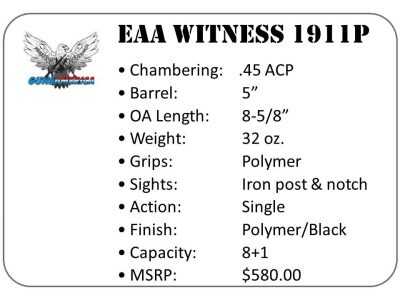 We all know that 1911 enthusiasts can really be snobs. I know, because I can be a 1911 snob with the best of them. Not because I’m the smartest guy in the room when it comes to the iconic pistol – I promise you I’m not. And not because my legendary marksmanship makes my every utterance a treasure trove of information – if there is any legend to my marksmanship, it’s the “I can’t believe he blew that shot” type. No, I can be a 1911 snob for the same reason a lot of gun folk can be – because it’s a way of establishing ourselves as “serious” enthusiasts. To be taken seriously in any high-stakes 1911 debate, you must know when to raise an eyebrow in approval and when to scoff. And if you want to raise the collective blood pressure and volume level of everyone in the room, just say three words: “polymer framed 1911”. Okay, the last one was really a number, but you know what I mean. So, imagine my pleasant surprise when I started testing this Witness 1911P from EAA… and liked it! And yes, the “P” is for polymer.
We all know that 1911 enthusiasts can really be snobs. I know, because I can be a 1911 snob with the best of them. Not because I’m the smartest guy in the room when it comes to the iconic pistol – I promise you I’m not. And not because my legendary marksmanship makes my every utterance a treasure trove of information – if there is any legend to my marksmanship, it’s the “I can’t believe he blew that shot” type. No, I can be a 1911 snob for the same reason a lot of gun folk can be – because it’s a way of establishing ourselves as “serious” enthusiasts. To be taken seriously in any high-stakes 1911 debate, you must know when to raise an eyebrow in approval and when to scoff. And if you want to raise the collective blood pressure and volume level of everyone in the room, just say three words: “polymer framed 1911”. Okay, the last one was really a number, but you know what I mean. So, imagine my pleasant surprise when I started testing this Witness 1911P from EAA… and liked it! And yes, the “P” is for polymer.
The Witness 1911P comes with one eight-round Mec-Gar magazine that is very good quality. The magazine has a steel body with a black finish, and an oversized polymer baseplate. The upper portion of the pistol – slide assembly, hammer, and top controls – is steel. The frame rails are abbreviated as compared to the traditional full-length rails of a steel frame, but they are very generous compared to most modern poly guns. The front set of rails is part of a block that also includes the feed ramp, and is pinned in place within the polymer frame.
If you hide your magnets for a moment, the Witness 1911P is in most ways a straight-up GI spec 1911, with a few of the usual modernizations.

Once you get past your phobia of touching a poly-framed 1911, you discover that this is a pretty decent pistol – perhaps one of the best in its class.
The number that differs the most is of course, the weight of the pistol. At only 32 ounces – just a couple ounces more than a Glock 21, this is a light 1911. People I handed it to always remarked, “it feels just like my M&P” (or Glock, or XDM… you get the picture). Because of that, I was quite curious what the recoil would feel like. After all, the weight of an iron pistol absorbs a good amount of the energy when fired. But then, so too does the micro-flexing of the polymer framed guns. A poly-framed 1911 might just be the best way to once and for all determine which one shoots “softer.” The answer to that, for this shooter, is that you do feel more recoil with a polymer framed 1911 than you do a full steel gun. It’s not considerable, nor is it in any way abusive or unmanageable, but it’s there. The trade-off is weight. You can wear the 1911P on your hip all day without the feeling that a small child has hold of your belt and won’t let go. Where It Counts Aside from the heresy of a polymer frame, the Witness 1911P is a very traditionally built pistol, and one that John Moses Browning would certainly recognize. It’s a traditional five-inch barrel with a bushing and a short guide rod. The sights are reminiscent of the staked-on GI sights. While both front and rear are drifted into dovetail cuts, the shape and simplicity is pure old school. The sight picture is black on black blade and notch – no dots or lines. The manual thumb safety is also a more traditional design that is narrower than many modern-era controls. It provides less shelf to rest the thumb on, but is also more snag-free. The operation of the safety is so-so. It engages softly, with no audible feedback and very little tactile feedback. I did several tests to be sure I had it fully engaged before I trusted it and made the gun hot. However, disengaging the safety is crisp and provides a nice ‘click’.

The basic design is GI, with a few ‘extras’ such as a tac rail, lightened hammer, and enhanced grip safety. The guide rod and plug are also polymer.
The slide stop lever is nicely checkered and operated perfectly. The magazine disconnect button is a bit stiff, but functioned as it should. Some magazines dropped free – some didn’t. The EAA-provided mags did, and also functioned very well during all testing. As with all 1911s, you will have to learn which aftermarket magazines it likes best and which ones just aren’t reliable. I’ve found this to be true with a $600 piece and a $4,000 piece.
The grip safety operated effectively, but it also tended to beat my palm while shooting, and in conjunction with the mainspring cover, contributed to felt recoil. The aforementioned mainspring cover, or back strap – is arched and of the style that juts out at the bottom. Some shooters seem to prefer this style grip because it changes the grip angle. I’m not a fan, and prefer a traditional flat mainspring cover with some nice checkering. The grip safety has been fitted to be flush with the extended back strap, which makes the ‘speed’ or ‘memory’ bump and mainspring cover become a narrow band of steel that focuses recoil energy straight into your palm. This, combined with the lightness of the poly frame is what I consider the main culprit of the added felt recoil.
The hammer is skeletonized and the common “U” shaped hollow spur that most current 1911s use. Spring tension seemed good, strikes were firm and crisp. Moving forward, the trigger is very no-frills. It is a plain-sided trigger that is not lightened with any holes or cutouts. It has a good face with full-length vertical serrations and pulls at around 6 ½ pounds. Not a bad trigger for an entry-level 1911. There is a bit of grit in it, but it didn’t keep me from enjoying shooting it and printing nice groups.
[one_half]
[/one_half]
[one_half_last]
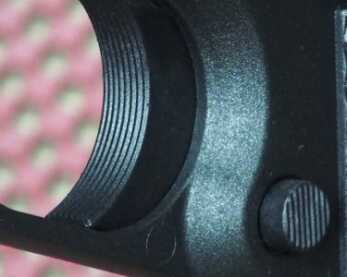
Ergonomically, the trigger is very good. It is heavy, though, and not totally grit-free. This should be expected at this price.
[/one_half_last]
Forward of the trigger guard is a generous amount of 1913 Picatinny accessory rail. Enough to mount your favorite light/laser combo and keep everything aft of the muzzle in most cases. This does mean that it won’t fit your molded 1911 holster for non-rail models, so bear that in mind. Just above the dust cover, in the slide and trapped by the barrel bushing, is the guide plug – which is also made of light polymer.
SHOOTING THE WITNESS 1911P
 I confessed up front about my ability to be a gun snob from time to time, but in all honesty, I strive not to be one. Like many things in life, once we close our minds to different ideas – we rob our lives of some nice experiences. I was pleased at just how good a shooter this EAA Witness 1911P is! From off-hand shooting at combat distances between 7-10 yards, to rested accuracy tests at 25 yards, this pistol produced impressive and consistent results with a variety of ammo. With SIG Sauer Elite Performance V-Crown ammunition the 1911P produced a four-shot group of all-holes-touching from a rest at 25 yards! I would not expect better from the most respected custom shop at nearly eight times the price! Remember, this is a sub-$600 pistol which will most likely retail closer to $500.
I confessed up front about my ability to be a gun snob from time to time, but in all honesty, I strive not to be one. Like many things in life, once we close our minds to different ideas – we rob our lives of some nice experiences. I was pleased at just how good a shooter this EAA Witness 1911P is! From off-hand shooting at combat distances between 7-10 yards, to rested accuracy tests at 25 yards, this pistol produced impressive and consistent results with a variety of ammo. With SIG Sauer Elite Performance V-Crown ammunition the 1911P produced a four-shot group of all-holes-touching from a rest at 25 yards! I would not expect better from the most respected custom shop at nearly eight times the price! Remember, this is a sub-$600 pistol which will most likely retail closer to $500.
During my range work with the 1911P, which encompassed several trips to the range and hundreds of rounds of varying types of ammo, I only experienced one problem with the gun. It seemed to have some issues with certain magazines –I’m talking about very familiar brand names, like Wilson Combat and Chip McCormick. So, on the odd chance that perhaps there was some issue with this one pistol, EAA and I agreed that it should be swapped out. I tested the new gun and had similar results. Far from being an exhaustive scientific test, but using basic troubleshooting 101 skills, I found that the pistol simply does not care much for those magazines. There were some that it did like, such as Kimber and Cobra, to name a couple – but what it really likes is the Mec-Gar magazine that it comes with. The first gun came with two, the second came with one. Aside from one feeding error with the first pistol, that I think may have been attributed to a flaw in the feed ramp, I had no malfunctions with the stock Mec-Gar magazines. If you’re a 1911 enthusiast, then you know only too well that finding the right gun/mag combo is about as important as the suspension and tire combination on a race car. For this gun, you’re well advised to stick with Meg-Gar and carefully test others before building up a supply.
[one_half]
[/one_half]
[one_half_last]
[/one_half_last]
[one_half]
[/one_half]
[one_half_last]
[/one_half_last]
All of the other aspects of shooting the Witness 1911P were typical 1911. The felt recoil is a bit more than you will feel with a steel or even alloy frame, but not significantly so. The 1911P comes with the arched mainspring cover, and if you prefer the flat variety like me, you’ll feel the difference there. The grips are actually part of the polymer frame, and although they look like they could be removed, the screws are fake. But the good news is that they feel great in the hand and provide very nice traction, even with sweaty hands. The front strap is smooth. The beavertail is generous and comfortable, as is the grip safety – which has the memory bump.
[one_half]
[/one_half]
[one_half_last]
[/one_half_last]
The sights are a throwback, as they are old style iron sights that basically give you post-and-notch. We’ve all gotten spoiled by the modern sights with buzzers and runway strobes and the like, but after you take a minute to remember your fundamentals, the sights are quite good, and refreshingly non-distracting. If you want the dancing neon lights instead – they can be easily replaced.
JUST MY OPINION
If you’re looking for an entry-level 1911, or you just want a basic-plus pistol, the EAA Witness 1911P is one that I think you need to consider. The value here is that they put the money and effort where it counts most and have built a pistol that is more accurate than some costing twice as much. They give you a tactical rail for accessory use, a very durable finish on the slide, tough iron sights and a decent trigger – all for less than you can get most of the duty sized brand-name striker-fired guns for. Not everyone thinks that a decent 1911 needs to cost a couple grand, and EAA is clearly among them.
For more information, visit https://eaacorp.com/index.php/guns/handguns/witness-elite-1911-polymer-tanfoglio-22.
To purchase on GunsAmerica.com, click this link: https://www.gunsamerica.com/Search.aspx?T=Witness%201911P.
[one_half]

The 1911Ps seem to have a flaw in the feed ramp (see arrow) that can add to feeding problems. Certain magazine brands appear to be more affected by this than the stock magazine.
[/one_half]
[one_half_last]

The screws on the one-piece polymer frame with integral “grips” are so realistic looking – the author was tricked in to putting a wrench to it… just to be sure.
[/one_half_last]

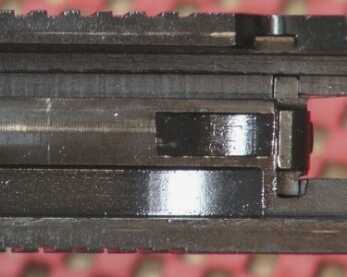

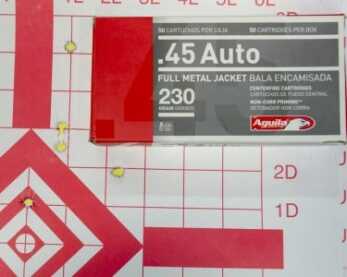

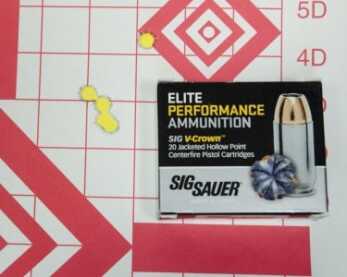
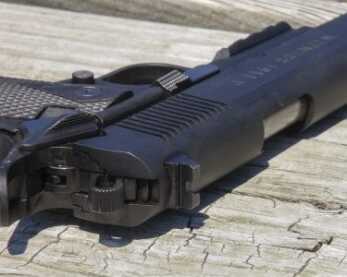
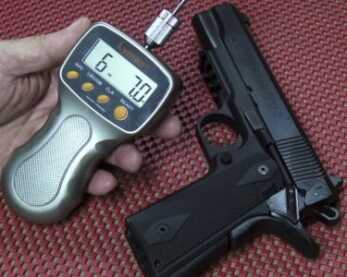
Chip Mccormick magazines give my 1911’s fits.The follower drags up and out into the chamber with the last round.Jams the guns up HARD.Rock Island Govt model and Officers model. Mec gar all the way.
One has to wonder why they chose polymer. At 32 ounces, it’s actually heavier than a comparable alloy-framed 1911, and not that much lighter than an all-steel Government model (Colt’s current full-size 1991 weighs in at 35 ounces). And the EAA is a curious mix, with a light rail on the front but a WW1-design receiver without the scallop cuts behind the trigger. Very peculiar. I’d like to try shooting one.
Price point. Polymer frame is much less expensive to manufacture.
The first plastic 1911 I ever saw was a Kimber wide body, I bought it and was never happy with it, I can’t tell you why but it just was what it was. I had a Para P-14 prior to that and loved it, sold it after I got the Kimber, bad things man. Sold the Kimber.
I’ve also never liked the alloy framed 1911’s, I guess it’s just me. I will pass on this one as well. But it was a good review.
I’ve seen these advertised under $500.00, and as I reach for the buy it now button I remember the burning pain from the sting of the “Llxxa” 1911 45acp pistols from the mid 1980s. Pretty to look at nice to hold but really nothing but a hand full of garbage. It’s refreshing to read this article.
To the extent this is absolutely honest 411, no hype, no consideration for advertising dollars like the mid 1980s “pizza” special pistols, then I’m excited to the extent of daydreaming about a lightweight officers size .40 S&W 7 found model in parkerized black, a defender size 9mm (8 rounds), last and hardly least a Commander size well equipped 10mm. Well equipped could include: rounded edges and ejection port, three dot night sight Bomar style sights, beveled magazine housing, skeletonized trigger with 5 lb pull, and a rail for those who need extra gear hanging on their tools of the trade. Make it modular and tough enough for SOCOM, Border Patrol, Miltary Crimminal Investigative services, and make it easy to disassemble decon and reassemble for ERT/SRT units. If you must, make a 9mm conversion kit for NATO, make a .22lr conversion kit for inexpensive training and proficiency firing. Just make it.
While I’m dreaming make an OD green with black grips full size 9mm version, and make a 1911-A1 full size, weight and feel .22 WMR version. Challenge Colt, Remington, Ruger, Taurus, or all comers to make any or all of these!
What was not clear was how many feed failures occurred with what ammo which is just as likely to be at fault as the magazines. I noticed at least two FTF in the video with the Sig ammo and have to suspect it. I bought a thousand rounds last year and had so many FTFs in just 1-1/2 boxes I gave the rest away. These occurred in both my Sig P220 Carry and an FN FNP, however a Kimber ate them like candy. Go figure.
Wondering if the feed ramp can be polished to eliminate the feed problem. If that, and the trigger pull are the only great drawbacks, then it should be a good EDC. 6 oz. doesn’t sound like a lot , but carrying it all day on your hip can really drag your pants down; even with a belt.
Purchased the conical barreled Commander 9mm. Fed well, no malfunctions. Several different mags tried, not a failure. Groups very well and decent trigger. It does shoot low to point of aim. Will try different ammo and bullet weights next.
6 ounces lighter – not a big difference, unless you just prefer polymer..I’d stay with ATI, TISAS, Armscor, etc…
Would love to see a 9mm and 10 rounds